Search Products
Return To Blog
What are those trees with the remarkable yellow leaves?
How to prevent and cure Iron Chlorosis
By Chris Leinster - June 13, 2018
You may be wondering “What are those trees with the remarkable yellow leaves?†With rare exception, what you are witnessing is not a tree with ornamental yellow leaves, but rather a tree whose leaves ought to be green but is suffering from a nutrient deficiency called iron chlorosis. Iron, the same element that holds up our bridges and skyscrapers, is a major building block of chlorophyll at the cellular level. Chlorophyll is responsible for photosynthesis, the process that converts sunlight into sugars and other nutrients.
Iron gives leaves their vibrant green color. Iron is abundant in our soils but often in a form chemically unavailable for plant uptake. When plants are unable to extract iron from the soil, they can’t manufacture chlorophyll. Without chlorophyll, the plants can’t produce the food they need to survive. The leaves turn yellow, weakening the plant until eventually it dies.
Treatment: The old adage “an ounce of prevention is worth a pound of cure†is appropriate here. It can be difficult and expensive to try to resuscitate a severely afflicted tree, but it is relatively easy to prevent the condition from occurring. There are many commercially available iron-based fertilizers with beneficial micronutrients such as manganese, copper, zinc, and boron, which can also lead to chlorosis if deficient in the soil. If you are using regular iron-based lawn treatments in the spring time you are probably giving your trees the iron they need as well. See our blog on spring lawn fertilization for more information. Please note iron will stain concrete and masonry so sweep or otherwise remove all iron fertilizer from hardscape surfaces immediately after application!
If you notice yellowing of leaves, particularly on Maple and Oak, liquid iron foliar sprays should be immediately applied for a swift but temporary therapy. For mature or severely distressed trees consult an arborist for more aggressive treatment. For wide spread or persistent symptoms you may want to look into Sulphur-based fertilizers to lower your soil’s pH level, which can temper our alkaline soil and potentially release iron for the trees.
One of the most exciting recent advances in agricultural science is the introduction of live cultures of beneficial bacteria and fungi into our soil for the benefit of agricultural crops and landscape plants. While more research is needed, these microbes consume complex molecules and may be able to release iron and other micronutrients in simpler forms, making them chemically available to the plants. These products are now becoming commercially available and I would encourage you to seek them out at your local garden center or nursery and incorporate them into your gardening practices.
As you look around the next time you drive out to the airport you’ll get a good sense for what kind of trees like to live here, meaning virtually none. This is due in part to our alkaline soils binding up iron and other micronutrients, making them unavailable for our trees’ nutrition. With a little observation and fertilization, your favorite trees from similar climates around the world can be enjoyed all along Colorado’s Front Range for generations to come.
Â
Iron gives leaves their vibrant green color. Iron is abundant in our soils but often in a form chemically unavailable for plant uptake. When plants are unable to extract iron from the soil, they can’t manufacture chlorophyll. Without chlorophyll, the plants can’t produce the food they need to survive. The leaves turn yellow, weakening the plant until eventually it dies.
Treatment: The old adage “an ounce of prevention is worth a pound of cure†is appropriate here. It can be difficult and expensive to try to resuscitate a severely afflicted tree, but it is relatively easy to prevent the condition from occurring. There are many commercially available iron-based fertilizers with beneficial micronutrients such as manganese, copper, zinc, and boron, which can also lead to chlorosis if deficient in the soil. If you are using regular iron-based lawn treatments in the spring time you are probably giving your trees the iron they need as well. See our blog on spring lawn fertilization for more information. Please note iron will stain concrete and masonry so sweep or otherwise remove all iron fertilizer from hardscape surfaces immediately after application!
If you notice yellowing of leaves, particularly on Maple and Oak, liquid iron foliar sprays should be immediately applied for a swift but temporary therapy. For mature or severely distressed trees consult an arborist for more aggressive treatment. For wide spread or persistent symptoms you may want to look into Sulphur-based fertilizers to lower your soil’s pH level, which can temper our alkaline soil and potentially release iron for the trees.
One of the most exciting recent advances in agricultural science is the introduction of live cultures of beneficial bacteria and fungi into our soil for the benefit of agricultural crops and landscape plants. While more research is needed, these microbes consume complex molecules and may be able to release iron and other micronutrients in simpler forms, making them chemically available to the plants. These products are now becoming commercially available and I would encourage you to seek them out at your local garden center or nursery and incorporate them into your gardening practices.
As you look around the next time you drive out to the airport you’ll get a good sense for what kind of trees like to live here, meaning virtually none. This is due in part to our alkaline soils binding up iron and other micronutrients, making them unavailable for our trees’ nutrition. With a little observation and fertilization, your favorite trees from similar climates around the world can be enjoyed all along Colorado’s Front Range for generations to come.
Â

